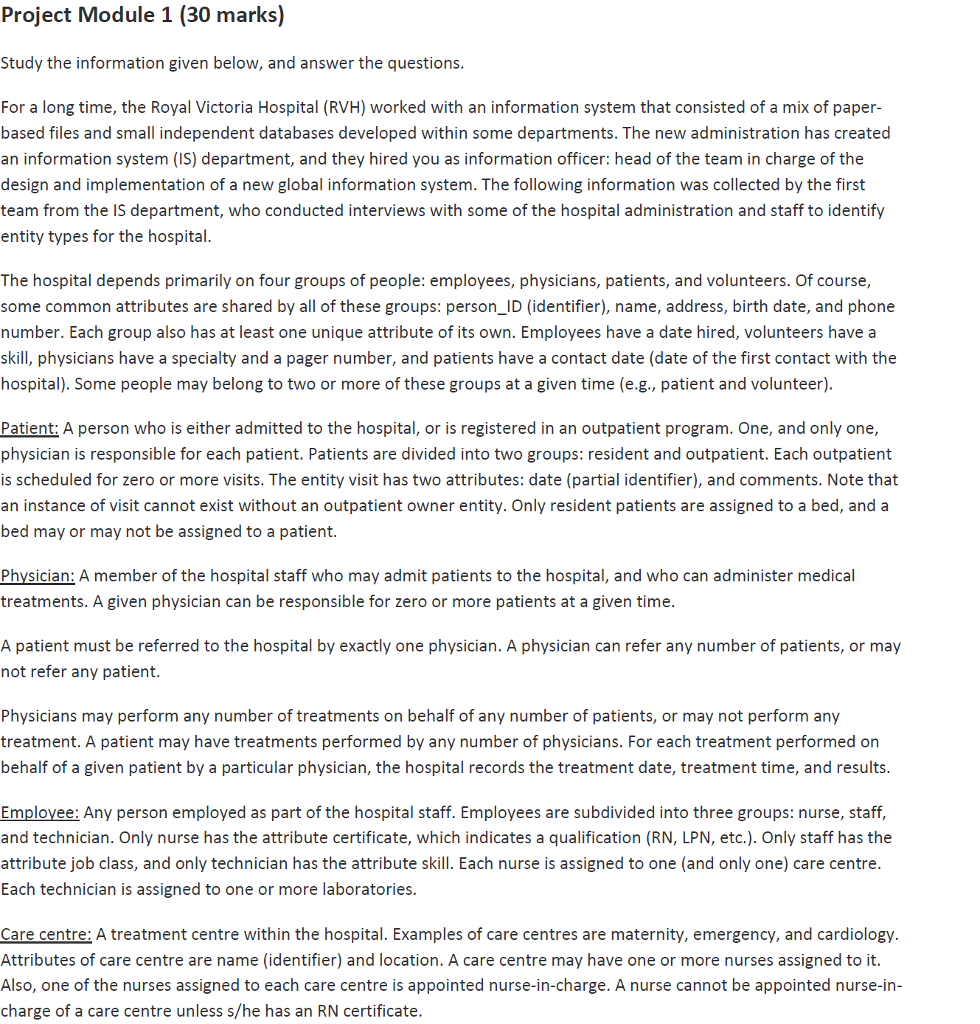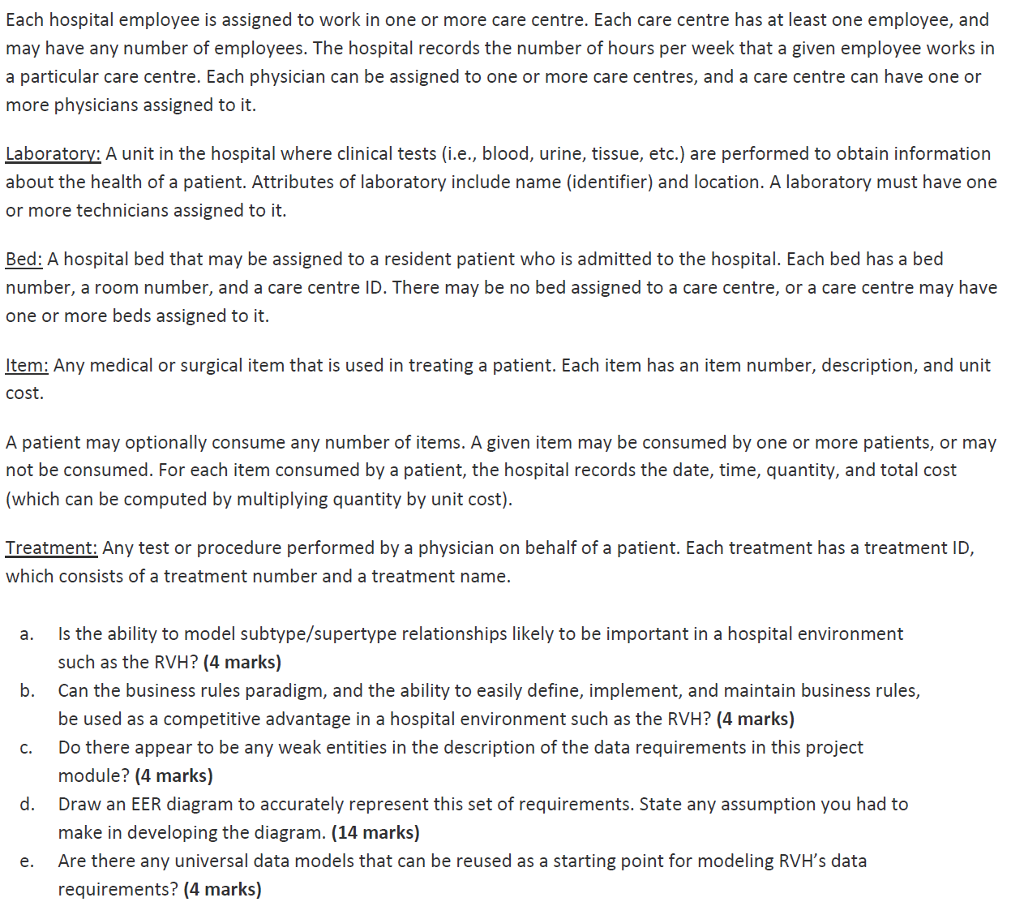Answered step by step
Verified Expert Solution
Question
1 Approved Answer
Pleaseeee Help me in this question as soon as possible Project Module 1 (30 marks) Study the information given below, and answer the questions For


Pleaseeee Help me in this question as soon as possible
Project Module 1 (30 marks) Study the information given below, and answer the questions For a long time, the Royal Victoria Hospital (RVH) worked with an information system that consisted of a mix of paper- based files and small independent databases developed within some departments. The new administration has created an information system (IS) department, and they hired you as information officer: head of the team in charge of the design and implementation of a new global information system. The following information was collected by the first team from the IS department, who conducted interviews with some of the hospital administration and staff to identify entity types for the hospital The hospital depends primarily on four groups of people: employees, physicians, patients, and volunteers. Of course, some common attributes are shared by all of these groups: person_ID (identifier), name, address, birth date, and phone number. Each group also has at least one unique attribute of its own. Employees have a date hired, volunteers have a skill, physicians have a specialty and a pager number, and patients have a contact date (date of the first contact with the hospital). Some people may belong to two or more of these groups at a given time (e.g., patient and volunteer) Patient: A person who is either admitted to the hospital, or is registered in an outpatient program. One, and only one, physician is responsible for each patient. Patients are divided into two groups: resident and outpatient. Each outpatient is scheduled for zero or more visits. The entity visit has two attributes: date (partial identifier), and comments. Note that an instance of visit cannot exist without an outpatient owner entity. Only resident patients are assigned to a bed, and a bed may or may not be assigned to a patient. Physician: A member of the hospital staff who may admit patients to the hospital, and who can administer medical treatments. A given physician can be responsible for zero or more patients at a given time A patient must be referred to the hospital by exactly one physician. A physician can refer any number of patients, or may not refer any patient Physicians may perform any number of treatments on behalf of any number of patients, or may not perform any treatment. A patient may have treatments performed by any number of physicians. For each treatment performed on behalf of a given patient by a particular physician, the hospital records the treatment date, treatment time, and results Employee: Any person employed as part of the hospital staff. Employees are subdivided into three groups and technician. Only nurse has the attribute certificate, which indicates a qualification (RN, LPN, etc.). Only staff has the attribute job class, and only technician has the attribute skill. Each nurse is assigned to one (and only one) care centre Each technician is assigned to one or more laboratories se A treatment centre within the hospital. Examples of care centres are maternity, emergency, and cardiology Attributes of care centre are name (identifier) and location. A care centre may have one or mor Also, one of the nurses assigned to each care centre is appointed nu charge of a care centre unless s/he has an RN certificate s assigned to it charge. A nurse carn t be appointed nurse-in- Project Module 1 (30 marks) Study the information given below, and answer the questions For a long time, the Royal Victoria Hospital (RVH) worked with an information system that consisted of a mix of paper- based files and small independent databases developed within some departments. The new administration has created an information system (IS) department, and they hired you as information officer: head of the team in charge of the design and implementation of a new global information system. The following information was collected by the first team from the IS department, who conducted interviews with some of the hospital administration and staff to identify entity types for the hospital The hospital depends primarily on four groups of people: employees, physicians, patients, and volunteers. Of course, some common attributes are shared by all of these groups: person_ID (identifier), name, address, birth date, and phone number. Each group also has at least one unique attribute of its own. Employees have a date hired, volunteers have a skill, physicians have a specialty and a pager number, and patients have a contact date (date of the first contact with the hospital). Some people may belong to two or more of these groups at a given time (e.g., patient and volunteer) Patient: A person who is either admitted to the hospital, or is registered in an outpatient program. One, and only one, physician is responsible for each patient. Patients are divided into two groups: resident and outpatient. Each outpatient is scheduled for zero or more visits. The entity visit has two attributes: date (partial identifier), and comments. Note that an instance of visit cannot exist without an outpatient owner entity. Only resident patients are assigned to a bed, and a bed may or may not be assigned to a patient. Physician: A member of the hospital staff who may admit patients to the hospital, and who can administer medical treatments. A given physician can be responsible for zero or more patients at a given time A patient must be referred to the hospital by exactly one physician. A physician can refer any number of patients, or may not refer any patient Physicians may perform any number of treatments on behalf of any number of patients, or may not perform any treatment. A patient may have treatments performed by any number of physicians. For each treatment performed on behalf of a given patient by a particular physician, the hospital records the treatment date, treatment time, and results Employee: Any person employed as part of the hospital staff. Employees are subdivided into three groups and technician. Only nurse has the attribute certificate, which indicates a qualification (RN, LPN, etc.). Only staff has the attribute job class, and only technician has the attribute skill. Each nurse is assigned to one (and only one) care centre Each technician is assigned to one or more laboratories se A treatment centre within the hospital. Examples of care centres are maternity, emergency, and cardiology Attributes of care centre are name (identifier) and location. A care centre may have one or mor Also, one of the nurses assigned to each care centre is appointed nu charge of a care centre unless s/he has an RN certificate s assigned to it charge. A nurse carn t be appointed nurse-inStep by Step Solution
There are 3 Steps involved in it
Step: 1

Get Instant Access to Expert-Tailored Solutions
See step-by-step solutions with expert insights and AI powered tools for academic success
Step: 2

Step: 3

Ace Your Homework with AI
Get the answers you need in no time with our AI-driven, step-by-step assistance
Get Started


